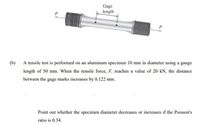
Elements Of Electromagnetics
7th Edition
ISBN: 9780190698614
Author: Sadiku, Matthew N. O.
Publisher: Oxford University Press
expand_more
expand_more
format_list_bulleted
Concept explainers
Question

Transcribed Image Text:Gage
length
P
(b)
A tensile test is performed on an aluminum specimen 10 mm in diameter using a gauge
length of 50 mm. When the tensile force, F, reaches a value of 20 kN, the distance
between the gage marks increases by 0.122 mm.
Point out whether the specimen diameter decreases or increases if the Poisson's
ratio is 0.34.
Expert Solution
This question has been solved!
Explore an expertly crafted, step-by-step solution for a thorough understanding of key concepts.
This is a popular solution
Trending nowThis is a popular solution!
Step by stepSolved in 2 steps with 2 images

Knowledge Booster
Learn more about
Need a deep-dive on the concept behind this application? Look no further. Learn more about this topic, mechanical-engineering and related others by exploring similar questions and additional content below.Similar questions
- His can you find answers for these please and explain how ? Thank youarrow_forwardHello, the stress and cycles required for this question is Stress 1 = 420MPa at 7 cycles, Stress 2 = 360MPa at 65 cycles and Stress 3 = 130MPa at 325 cycles. Use the first three cycles (which shows how many cycles at that stress level to failure) to calculate when the specimen will fail if it underwent test of 7 cycles at 420MPa, then undergoes 360MPa for 65 cycles and finally 130MPa at 325 cycles. Will the specimen fail? Please show calculations of failurearrow_forwardA tension test was performed on a specimen having an original diameter of 13.7 mm and a gauge length of 50 mm. The data are listed in the table. Load (kN) Elongation (mm) 0 11.1 31.9 37.8 40.9 43.6 53.4 62.3 64.5 62.3 58.8 0 0.0175 0.0600 0.1020 0.1650 0.2490 1.0160 3.0480 6.3500 8.8900 11.9380 Plot the stress-strain diagram. Use a scale of 20 mm = 50 MPa and 20 mm = 0.05 mm/mm. Redraw the linear-elastic region, using the same stress scale but a strain scale of 20 mm = 0.001 mm/mm. From the diagram, determine approximately the modulus of elasticity. Express your answer to three significant figures and include the appropriate units. E = Submit Part B συ = Submit Part C ☐☐ μÅ of = Value Determine the ultimate stress. Express your answer to three significant figures and include the appropriate units. Request Answer μĂ Value Request Answer Units μĂ - Value Units Determine the fracture stress. Express your answer to three significant figures and include the appropriate units. ? Units ? ?arrow_forward
- There may be cases where an extensometer is used in the metal tensile test and cases where it is not. At this time, explain the part where the most difference appears in analyzing the results of the two experiments.arrow_forwardAt operating stress of 420MPa, the number of cycles to fail a specimen is 65 cycles. At operating stress of 360MPa, the number of cycles to fail the specimen is 390 cycles, and at operating stress of 130MPa, the number of cycles to fail the specimen is 11,900 cycles. A test sequence as follows is designed: first, operating stress of 420MPa for 7 cycles, second, operating stress of 360MPa for 65 cycles, and third, operating stress of 130MPa for 325 cycles. Determine at what number of cycle and which operating stress level the specimen would be expected to fail if the above sequence is repeated.arrow_forwardIn a tensile test for an aluminum alloy, the sample is 2 inches long and 0.5 inches in diameter. The proportional portion of the tension stress-strain diagram for an aluminum alloy is shown below. Determine the axial stress of the sample under a tensile load of 9 kips: ____ ksi. Pay attention to units and calculate your answer to 1 decimal place.arrow_forward
- When a bar of 22 mm diameter is subjected to an axial pull of 60 kN the extension on the 49 mm gauge length is 0.1 mm and there is a decrease in diameter of 0.013 mm. Calculate the Young's Modulus. Provide your answer in GN/m2 to the nearest whole number.arrow_forwardELECTRICAL ENGINNERING THANK YOU SO MUCHarrow_forward
arrow_back_ios
arrow_forward_ios
Recommended textbooks for you
 Elements Of ElectromagneticsMechanical EngineeringISBN:9780190698614Author:Sadiku, Matthew N. O.Publisher:Oxford University Press
Elements Of ElectromagneticsMechanical EngineeringISBN:9780190698614Author:Sadiku, Matthew N. O.Publisher:Oxford University Press Mechanics of Materials (10th Edition)Mechanical EngineeringISBN:9780134319650Author:Russell C. HibbelerPublisher:PEARSON
Mechanics of Materials (10th Edition)Mechanical EngineeringISBN:9780134319650Author:Russell C. HibbelerPublisher:PEARSON Thermodynamics: An Engineering ApproachMechanical EngineeringISBN:9781259822674Author:Yunus A. Cengel Dr., Michael A. BolesPublisher:McGraw-Hill Education
Thermodynamics: An Engineering ApproachMechanical EngineeringISBN:9781259822674Author:Yunus A. Cengel Dr., Michael A. BolesPublisher:McGraw-Hill Education Control Systems EngineeringMechanical EngineeringISBN:9781118170519Author:Norman S. NisePublisher:WILEY
Control Systems EngineeringMechanical EngineeringISBN:9781118170519Author:Norman S. NisePublisher:WILEY Mechanics of Materials (MindTap Course List)Mechanical EngineeringISBN:9781337093347Author:Barry J. Goodno, James M. GerePublisher:Cengage Learning
Mechanics of Materials (MindTap Course List)Mechanical EngineeringISBN:9781337093347Author:Barry J. Goodno, James M. GerePublisher:Cengage Learning Engineering Mechanics: StaticsMechanical EngineeringISBN:9781118807330Author:James L. Meriam, L. G. Kraige, J. N. BoltonPublisher:WILEY
Engineering Mechanics: StaticsMechanical EngineeringISBN:9781118807330Author:James L. Meriam, L. G. Kraige, J. N. BoltonPublisher:WILEY

Elements Of Electromagnetics
Mechanical Engineering
ISBN:9780190698614
Author:Sadiku, Matthew N. O.
Publisher:Oxford University Press

Mechanics of Materials (10th Edition)
Mechanical Engineering
ISBN:9780134319650
Author:Russell C. Hibbeler
Publisher:PEARSON

Thermodynamics: An Engineering Approach
Mechanical Engineering
ISBN:9781259822674
Author:Yunus A. Cengel Dr., Michael A. Boles
Publisher:McGraw-Hill Education

Control Systems Engineering
Mechanical Engineering
ISBN:9781118170519
Author:Norman S. Nise
Publisher:WILEY

Mechanics of Materials (MindTap Course List)
Mechanical Engineering
ISBN:9781337093347
Author:Barry J. Goodno, James M. Gere
Publisher:Cengage Learning

Engineering Mechanics: Statics
Mechanical Engineering
ISBN:9781118807330
Author:James L. Meriam, L. G. Kraige, J. N. Bolton
Publisher:WILEY